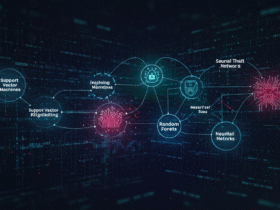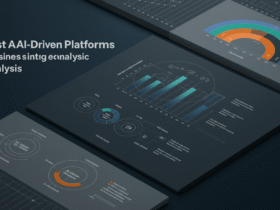Nowadays, our digital world requires more protection against cyber threats, which are becoming more advanced and frequent. The traditional approaches of network security can no longer help protect against the modern cyberattacks, as businesses are increasing the use of their digital infrastructures.
It is here that Intrusion Detection Systems (IDs) with Artificial Intelligence (AI) are used.
Next-generation security with AI IDS solutions is the next step in security that uses machine learning (ML), behavioral analytics, and real-time monitoring to detect and prevent the threats and mitigate them in a highly effective and fully automated way.
What Are Intrusion Detection Systems (IDS)?
Understanding Intrusion Detection Systems
An Intrusion Detection System (IDS) is network security technology that watches and examines network traffic to identify indicators of incumbency, unapproved access, or policy violations. It operates by detecting the possible threats and sending the information to the security team to enable them to take the necessary measures.
IDS may be defined broadly as:
-
Network-based IDS (NIDS): As the name says it examines network traffic network traffic.
-
Host-based IDS (HIDS): Concentrating on the individual device or endpoint, files, applications, and system processes are scrutinized with the help of file, application monitoring, and system process in search of evidence of compromise.
-
Hybrid IDS: Integresholds both the capabilities of a NIDS and a HIDS together as a more holistic form of security.
Traditional IDS vs. AI-Powered IDS
Conventional IDS systems are mainly signature-based or rule-based systems, so they correspond the incoming data patterns with known attacks. Although these systems work well to detect known threats, they usually fail to detect new, unknown, or emerging threats. They are also prone to emails that present high numbers of false positives that may be too much to handle by security personnel.
AI-powered IDS is a kind of AI-based IDS that performs basing on the advanced machine learning algorithms and AI models because it actively keeps learning more from the data and categorizing the abnormalities and threats that do not necessarily fit the established signatures. Using real-time analysis of the massive amount of data, AI-based systems can identify the previously undiscovered attacks, minimize false alarms, and offer a more responsive defense system.
Why AI is Needed in IDS
The principal arguments in support of AI vital in IDS relate to the following:
-
Increased sophistication of cyber threats: The cyber attackers have come up with new and sophisticated methods including the use of polymorphic malware and APTs (advanced persistent threats), which have the ability to bypass the traditional systems of security.
-
Volume of data: Because the amount of traffic that is produced by contemporary businesses is enormous, detecting these threats manually is becoming strenuous.
-
Real-time response: Cyberattacks are known to take place in real time today, and a quick detection and subsequent mitigation is the key to ensuring limited harm during an attack.
With the help of AI, IDS solutions will be slightly more smarter and capable of detecting new vectors of attacks, including those that are not associated with the traditional patterns of attacks.
How AI Powers Intrusion Detection Systems
Machine learning, which falls under AI technologies, is transforming IDS: systems can analyze huge datasets, see patterns in them, and then change according to emerging threats. The following are the ways in which AI improves intrusion detection:
Machine Learning for Threat Detection
Machine learning is the application of an AI in teaching algorithms to recognize data patterns or learn to draw conclusions and or make a decision without specific programming. In IDS setting, ML algorithms process past records of network traffic and generate models of normal network traffic. Trained, the system will raise alarms on any deviation of this norm as a possible malicious activity.
-
Supervised Learning: Here one trains the model on a labeled data (e.g. known attacks or benign activity). The AI system consequently profiles potential occurrences based on this information and hence identifies similar trends in the future traffic.
-
Unsupervised Learning: The system has the ability to learn anomalies detection without a pre-labeled data and identifies a new or unseen attack based on uncommon behavioral patterns.
-
Reinforcement Learning: This learning helps the system to keep on improving as it gets rewarded on how it chooses its decisions in the future thus being able to detect threat more accurately as time goes.
Real-Time Anomaly Detection
One of the most powerful features of AI-powered IDS is its ability to detect anomalies in real time. Unlike traditional systems, which require manual updates and static rules, AI-driven IDS can continuously monitor the network, compare activity with established baselines, and immediately flag any suspicious behavior.
This real-time capability is critical for organizations dealing with sophisticated cyber threats that evolve quickly. The AI system doesn’t just look for specific signatures; it identifies outliers, such as an unusual login time, an unfamiliar IP address, or abnormal network traffic, all of which could indicate a potential attack.
Behavioral Analytics and Threat Prediction
Anomaly detection is one of the strongest capabilities of AI-based IDS to identify the peculiarities of the working process in real-time. Contrary to traditional systems, where rule formats are fixed and updates are made manually, AI-driven IDS allows constantly monitoring the network and comparing the activity to the already created baselines to detect any potentially suspicious activity in real-time.
Reduced False Positives
The legacy IDS products are usually dogged with a lot of false positives, that is, secure behaviors that are detected as malicious ones. Not only this squanders precious resources but it also results in the so-called alert fatigue when security teams begin to ignore alerts.
| AI Capability | How It Enhances IDS | Business Benefit |
|---|---|---|
| Machine Learning | Learns from network behavior to detect both known and unknown threats | Improves detection accuracy, adapts to new attack vectors |
| Real-Time Anomaly Detection | Identifies deviations from normal network behavior in real time | Enables quick response to cyberattacks, minimizes damage |
| Behavioral Analytics & Threat Prediction | Monitors user activity and predicts future threats | Proactively mitigates potential threats before they occur |
| Reduced False Positives | Continuously refines detection models, reducing unnecessary alerts | Improves resource efficiency, reduces alert fatigue |
Benefits of AI-Powered IDS for IT Security
There are many advantages of AI-based IDS that could never be offered by any other system. The key benefits of implementing AI-powered intrusion detection, in the domain of the IT security, are as follows:
Increased Accuracy and Efficiency
AI systems can examine an immense amount of the data and identify threats more precisely. AI can also handle large amounts of data in genuine time by locating anomalies and possible threats swiftly and feasibly without utilizing the human analyst.
Example: AI IDS systems with be able to monitor the network traffic without any compromises and all operations within the network will thus be clicked through to either detect threats or not, regardless of the size or complexity of the network.
Faster Response Times
Businesses have the potential of automatically reacting to threats in real time with the help of AI powered detecting systems. AI systems have a potential to execute predetermined methods immediately when the threat is identified, including isolation of the affected systems, malicious traffic interception, or alerting the security team.
Example: AI systems will allow redirecting traffic instantly during a DDoS attack, or an AI system will implement mitigative actions to help companies evade downtime and service interruption.
Proactive Threat Prevention
The AI-based IDS mechanisms come not only to detect the threats already happened but also to foretell and preclude future attacks. AI models may enable organizations to act proactively by adding defenses to their networks, before the attack occurs, so it is possible to mitigate the damage caused by that particular threat.
Example: Predictive analytics can assist a firm to know which aspect of its network is most prone to attack so that it may advance more security in anticipation.
Scalability and Flexibility
IDS systems based on AI can be expanded easily when your network is expanded. As an enterprise grows, adding more endpoints, more data traffic, and going to the cloud, the security systems based on AI can keep up with the increasing demands of the business, and still, reach the performance levels required by the situation.
Example: AI based IDS engine such as Darktrace, is able to scale to large enterprise networks, thus ensuring security in distributed environments, with real-time spy capabilities.
Lower Operational Costs
Although AI-based IDS systems might be more expensive to implement, they can serve as cost-efficient in the long term since they automate the process of detecting threats, decrease the number of security specialists needed in the team, and minimize losses due to cybersecurity breaches.
Example: AI enables blocking potential attacks without the need to monitor incoming alerts that can be spotted and prevented by the security officers then.
| Benefit | How AI Improves Security | Business Impact |
|---|---|---|
| Increased Accuracy & Efficiency | Analyzes large datasets in real time, detecting threats with precision | Improved threat detection, reduced manual intervention |
| Faster Response Times | Automates threat responses, acting immediately on detected threats | Minimizes damage, reduces response time |
| Proactive Threat Prevention | Predicts future attacks and allows businesses to act before they occur | Prevents breaches, strengthens defenses |
| Scalability & Flexibility | Easily adapts to growing networks and cloud environments | Ensures continuous protection as businesses expand |
| Lower Operational Costs | Automates routine security tasks, reducing the need for a large team | Reduces security team workload, cuts long-term costs |
Challenges in Implementing AI-Powered IDS
In as much as there are many advantages to adopting IDS that are run using AI, there are a number of challenges in implementation. These are the issues that organizations must resolve to effectively implement AI-powered security solution:
Data Privacy and Compliance Concerns
IDS based on AI vectors ask to rely on huge volumes of data to train and work correctly. This data could contain sensitive data and, therefore, questions will be brought up regarding data privacy and regulation compatibility (GDPR, HIPAA, CCPA, etc.). A guarantee that AI-powered IDS go in line with the rules of data protection is of the essence to businesses operating with sensitive data about customers or employees.
Solution: Companies should introduce data governance guidelines, so that AI can follow privacy laws. This encompasses the anonymization of vulnerable data and cryptography of the communications channels, so only the AI systems will not be able to process the data, but it will not stem the risk of data exposure.
Integration with Legacy Systems
The network security solutions, including firewalls, and customarily, IDS systems, are already in use by many businesses. The process of connecting IDS that uses AI to these legacy systems may be detailed and lengthy. The newer systems might not be compatible with the older systems necessitating a huge adjustment to infrastructure.
Solution: AI-powered IDS solutions should be selected to provide an easy upgrade of the current security system. Numerous AI-based platforms are developed flexibly nowadays, which simplifies the task of their safe integration with existing network security designs.
Cost and Resource Allocation
The integration of AI-based IDS4 can be a challenging expenditure concerning funds and man-hour. Although AI solutions could lead to significant long-term advantages, the cost incurred in the process, i.e. acquiring, assimilating, and supporting AI tools can be an obstacle in the way of some companies.
Solution: he firms can also look into using cloud-based AI security services that are more scalable, and the capacity is less expensive to implement. Also, AI tools that charge a subscription fee will enable businesses to pay their own consumption.
Skills Gap
With the help of AI, IDS is a feature which needs special expertise to utilize and maintain. The personnel of the security teams might lack the right skills in the machine learning or AI algorithms that might also provide an obstacle to a successful implementation of the solutions in the existing networks.
Solution: To overcome the problem of the skills gap, companies can organize training of the current IT personnel or recruit workers with specific knowledge on AI and cybersecurity. Besides, numerous AI security providers provide trainings and certifications that can be used to familiarize teams with new tools.
| Challenge | How to Overcome It | Business Benefit |
|---|---|---|
| Data Privacy & Compliance | Implement data governance, anonymization, and encryption | Ensures legal compliance and protects sensitive data |
| Integration with Legacy Systems | Use flexible AI IDS that integrate with existing infrastructure | Smooth deployment, no disruption to existing systems |
| Cost & Resource Allocation | Choose cloud-based or modular AI IDS solutions | Reduced upfront investment, scalable pricing options |
| Skills Gap | Train in-house staff or hire AI security experts | Better deployment, improved management of AI-powered IDS |
The Future of AI-Powered IDS
The AI-driven intrusion detection systems have a bright future, and the further evolution of AI and machine learning would impact the future of cybersecurity. Due to the improved and better cyber threats, AI will get a more significant role in defending with real-time, proactive protection. Some of the trends and developments to look out for are as follows:
Autonomous Security Systems
In these technological advancements, the use of AI is bound to expand even further and intrusion detection systems will become even more autonomous. In the future, AI-based IDS will have this capability in addition to detecting and responding to threats in real-time, which is to make decisions without involving human beings. This will assist organizational enterprises to speed up their response and reduce cyberattacks.
Example: The AI systems are also capable of self-quarantining the affected machines, blocking the malicious IPs, and doing other mitigating steps to contain the threat more quickly than what a human security team can.
Integration with Other Security Solutions
In the future, AI IDS will be more integrated with other security controls, including, endpoint protection systems, SIEM (Security Information and Event Management) solutions, and firewalls. The integration will give a single defense, which will be able to sense and react to any threats within the whole network.
Example: AI IDS may be able to talk to a firewall and make dynamic use of security rules depending on continually carried out threat analysis thus strengthening protection.
Improved Behavioral Analytics
Behavioral analytics will grow even more as AI moves forward. The IDS systems powered with AI will be capable of interpreting not only conventional network traffic but also user and device behavior, health, as well as context-aware actions. It will assist organizations to identify insider threat, hijacked accounts and sophisticated attack schemes.
Example: AI may also detect and prevent the abnormal human activity, i.e., an employee that viewed classified information to which he/she does not have an access regularly, which points to a violation or privilege abuse.
Enhanced Cloud and Hybrid Security
With organizations relocating to the cloud and implementing hybrid IT systems, the AI-powered IDS solutions will play a significant role in protecting these complicated systems. Due to its flexibility, AI will offer visibility and protection in both on-premises and cloud environments and have an ability to adjust to the peculiarities of cloud-based and hybrid networks.
Example: AI IDS will also have the ability to actively operate cloud trafficking and identify unsolicited access, as well as maintaining secured cloud infrastructure even when emerging cloud technologies are entering the market.
| Future Trend | Description | Business Impact |
|---|---|---|
| Autonomous Security Systems | AI IDS will make decisions and respond without human intervention | Faster response to threats, reduced human error |
| Integration with Other Security Solutions | AI IDS will work seamlessly with other cybersecurity technologies | More comprehensive and unified security infrastructure |
| Improved Behavioral Analytics | AI will analyze user behavior and device health to detect threats | Better detection of insider threats and compromised accounts |
| Enhanced Cloud & Hybrid Security | AI IDS will provide protection across both on-premises and cloud environments | More robust security for complex, hybrid IT environments |
Summary
The future of network security would be revolutionized with something defined by the tremendous capabilities of the AI-based intrusion detection systems, which provide more than the traditional IDS. AI-driven systems can increase the strength of defense against cyber threats by being able to detect the anomalies in real time and taking preventative actions before an attack occurs due to machine learning, anomaly detection, and predictive analytics. With the evolution of cybersecurity, the IDS armed with AI will become more essential to keep an organization ahead of the game against cybercriminals.





























Leave a Reply